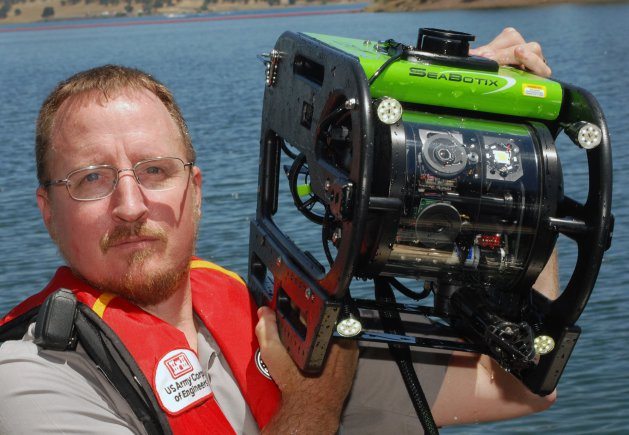Rising out of the depths of New Hogan Lake is an odd underwater entity. It has bright, glowing eyes, a single powerful claw and a bright green tail that’s hundreds of feet long. Fortunately, it obeys every command of the Sacramento District Park Rangers stationed at the surface.
This is an underwater remotely-operated vehicle, or ROV, one of two operated by the district to give the team a way to assess underwater elements of our mission without requiring full dive crews. One ROV is stationed at New Hogan Lake and the other at Pine Flat Lake.
A half-dozen park rangers have been trained to use and maintain these high-tech underwater robots.
Similar ROVs are used by U.S. military for underwater security inspections, says John Chapman, a ranger at New Hogan Lake and one of the first class of personnel trained to operate and maintain the ROVs.
District ROV operators have assisted in recovery of two drowning victims’ bodies — one from Lake Kaweah in 2010 and another from a mining pit in Tuolumne County on April 11, 2011. In addition, the special team was called into service to help examine the floor of the Oakland turning basin in San Francisco Bay in March of 2010.
Charles Jeung , program manager for Sacramento District’s dam inspections group, says the ROVs have the potential to become a valuable tool for inspecting dam intake structures, examining the upstream face and confirming proper function of bulkhead gates — all underwater elements that might otherwise require a dive crew.
The robots could also be called upon to conduct hull inspections and help rangers watch for invasive species clinging to underwater structures, says Jonathan Friedman, senior district ranger.
Each unit is equipped with color and high-resolution black-and-white video cameras; a bank of high-intensity LED lights; and sonar. Operation is accomplished by a small team – one to “fly” or maneuver the vehicle and one or two more to mind the umbilical cable and assist with topside communication, sonar operations and support, says Chapman.
The robotic submarine is maneuvered using four onboard thrusters — propellers driven by electric motors. Inside the clear plastic nose sit the two swiveling video cameras and the sonar unit is mounted on top. The powerful three-jaw grabber points forward in a position where the pilot can manipulate it while watching it on the video monitor.
Along with the ROV unit, the operation requires a large reel of optical fiber umbilical cable, the control/viewing unit for the ROV pilot, a separate laptop computer for storing video files and a gasoline-powered generator. The umbilical cable sends power and control signals down to the unit and relays video and sonar imagery back to the surface.











